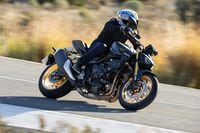They say: "Skyhook suspends you 'from above.'"
We say: "Angels still sing when we ride this bike."
We hesitate to use words like “passion” and “soul” when describing Italian bikes because they border on cliché. But the way the Ducati Multistrada rides is cause enough to embrace the terms, even if you cringe while saying them. It falls so sweetly into corners, carves effortless arcs, and fires toward the next curve with superbike power. It is for those reasons that the words “update” and “touring” can cause alarm. Or at least a little cognitive dissonance.
Ducati’s development staff listened to current Multistrada owners who said they wanted their bikes to be more touring oriented, and made suitable changes, but promised they have not lost sight of the Multi’s sporting roots. To achieve this feat, the folks in Borgo Panigale have placed most of their chips behind electronic suspension.
“Skyhook” is more than just an unused James Bond movie title; it represents Bologna’s idea for adaptive suspension that makes the bike feel like it is suspended from above. Ducati Skyhook Suspension (DSS) works by comparing data from four chassis-mounted accelerometers that informs electronic damping valves in the Sachs shock and the left side of the 48mm inverted fork. One accelerometer is placed near each wheel on the shock and fork; the remaining two are located above each wheel, in the sprung part of the bike. By processing the contrast between the four points on the chassis the bike is able to “read the road” as it passes and automatically adjusts the suspension damping to suit the situation.
The analogy used by the Multistrada’s project leader, Federico Sabbioni, was to consider how autofocus works on a camera. A lens can be focused on one point, but when conditions change, the image becomes blurry. The Skyhook system is trying to keep the road in focus. The most compelling data presented to illustrate this was a graph showing braking response. Where standard suspension compresses at a consistent rate under braking, DSS can actually increase compression damping, stiffening the fork under load and decreasing dive, therefore leaving more of the suspension stroke available to soak up irregularities in the road surface.
The semi-active DSS damping is an addition to an already extensive suite of electronics on the current Multistrada, including Ducati Electronic Suspension (DES) adjustment, Ducati Traction Control (DTC), and Bosch ABS. Skyhook interacts with the other systems via the selected ride-mode setting (Sport, Touring, Urban, or Enduro) as a starting point for adjustment. For example, in Sport mode speed is prioritized over comfort, meaning the DSS adapts more aggressive settings to increase sporty performance. Progressing from Touring to Urban to Enduro settings sees the damping soften in each mode respectively, and DSS response adapt accordingly.
Does it work? Data can show us that adaptive suspension reacts to braking forces and undulations in the road to create a more controlled riding experience, but it is a difficult thing to perceive when riding. From the saddle, it’s mostly the DES that transforms the Multistrada from canyon-carving sportbike-slayer to touring bike to grocery-getter and back. Independent of the DES modes, the system also includes electronic preload adjustability with modes for a solo rider, rider with luggage, rider with passenger, or rider with passenger and luggage.
In Sport the bike is rigid and somewhat unforgiving, with throttle response so sharp that one Ducati engineer on our ride admitted it was too severe even for him. Touring mode delivers the same overall power of Sport, but with a “gentle” map for those who want a friendlier version of 150 claimed horsepower and slightly more compliant suspenders. Urban mode transforms the motor to what Ducati calls a “gentle 100 hp,” instantly making it a more docile commuting machine.
Enduro mode softens throttle response by about 30 percent (same as Urban), but with more substantial automatic changes to DTC and ABS, which have both been refined for 2013. The ABS is now adaptive as well, meaning it uses accelerometer data to “decide” how much to mitigate braking. Although the test ride’s only off-road terrain was a short descent from a coastal road to the seaside on a dilapidated half-paved path, we were most impressed with the adaptive ABS in Enduro mode. The ABS does not allow full rear-wheel lock-ups but seems more lenient when intervening astern. In the same vein, the DTC in Enduro mode disallows big slides but continues putting power down even when traction is broken, whereas Sport mode on gravel was much more cautious.
Testing the DTC on pavement is a more delicate operation, but since it rained the night before our ride in and around Bilbao, Spain, testing the limits of the fat, 190-width Pirelli Scorpion Trail rear tire on damp paint lines and pine needles proved worthwhile. As with other DTC-equiped Ducati models, the corrections to save slides are abrupt but effective, and do well to remind the rider to be more careful.
And make no mistake, care is to be taken because sending power through the vast network of electronics is an updated 1198cc Testastretta 11-degree engine, the last remnant of the 1198 superbike. Despite receiving the final baptism of sport-touring detuning—a Dual Spark head—it still produces a claimed 150 bhp and nearly 92 lb.-ft. of torque. Fueling has been refined for 2013 as well, along with throttle response in the different power modes. The result is enough thrust to carry the front wheel easily in the first two gears and, with a little encouragement, third gear, too. If that sounds intoxicating, it is. In classic Ducati fashion, the brakes will cash any check the engine writes, with beefy four-pot radial calipers that squeeze 320mm floating discs.
The 2013 S Touring model we rode also boasts an optional 58 liters of pannier storage, heated grips, and a center-stand. This is the same bike, remember, that backs into hairpins like an Aprilia Tuono V4 and wheelies like a Triumph Speed Triple.
Because current Multistrada owners wanted more touring capability, in addition to the touring-oriented upgrades available on the 2013 model there is the S Gran Tourismo trim level. This means 20mm taller bars, a slightly larger windscreen, an upgraded seat, auxiliary spotlights, larger-capacity, 73-liter saddlebags, and a 48-liter top case.
The other end of the spectrum is the S Pikes Peak edition, which comes draped with carbon fiber bits, forged aluminum Marchesini wheels, and a look-at-me stripey paint scheme. The Gran Tourismo shares pricing with the Pikes Peak at a cool $21,995, with the S Touring priced at $19,995 and the base model coming in at $16,995. The non-S base model does not get the fancy new Skyhook or DES, but does get adjustable power modes and the Ducati Safety Pack that includes traction control and ABS.
Four trim levels mirror Ducati’s motto for the Multistrada of “four bikes in one,” a conceit that still smells of marketing gimmick. Fact is, though, technology has advanced to a point where three-bikes-in-one is realistic. In the not-so-distant past it was impossible to create a visceral motorcycle that would quench the thirst of thrill-seekers while providing a comfortable touring option and docile commuting manners. That time has come. This is that bike.
Tech Spec










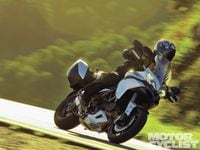

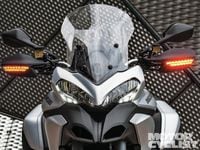

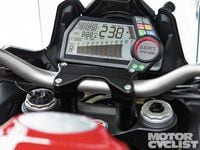
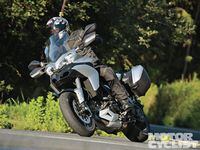
/cloudfront-us-east-1.images.arcpublishing.com/octane/OKWOJWAKP5EP3OACCRRWPCIX2Q.jpg)
/cloudfront-us-east-1.images.arcpublishing.com/octane/2WF3SCE3NFBQXLDNJM7KMXA45E.jpg)
/cloudfront-us-east-1.images.arcpublishing.com/octane/G4MG6OUCJNBSHIS2MVVOTPX65E.jpg)
/cloudfront-us-east-1.images.arcpublishing.com/octane/IIGGWFOTOJGB7DB6DGBXCCMTDY.jpg)
/cloudfront-us-east-1.images.arcpublishing.com/octane/QSTCM6AVEZA5JJBUXNIQ3DSOF4.jpg)
/cloudfront-us-east-1.images.arcpublishing.com/octane/U4I7G625B5DMLF2DVIJDFZVV6M.jpg)
/cloudfront-us-east-1.images.arcpublishing.com/octane/B6XD6LS6IVCQPIU6HXDJSM3FHY.jpg)
/cloudfront-us-east-1.images.arcpublishing.com/octane/ICL63FEDDRDTTMINYICCEYGMDA.jpg)
/cloudfront-us-east-1.images.arcpublishing.com/octane/FCGZHQXRBZFLBAPC5SDIQLVF4I.jpg)
/cloudfront-us-east-1.images.arcpublishing.com/octane/WNOB6LDOIFFHJKPSVIWDYUGOPM.jpg)

/cloudfront-us-east-1.images.arcpublishing.com/octane/X33NU3E525ECRHXLNUJN2FTRKI.jpg)
/cloudfront-us-east-1.images.arcpublishing.com/octane/6KKT5NNL2JAVBOXMZYS5ZO76YA.jpg)
/cloudfront-us-east-1.images.arcpublishing.com/octane/J5RKG5O455GMPGQRF2OG6LRT7A.jpg)
/cloudfront-us-east-1.images.arcpublishing.com/octane/GX2CIZKQVRH2TATDM26KFG2DAE.jpg)
/cloudfront-us-east-1.images.arcpublishing.com/octane/ZWIDYSAKQZHD5BHREMQILXJCGM.jpg)
/cloudfront-us-east-1.images.arcpublishing.com/octane/CYUHJZCTSJCH3MRAQEIKXK7SCQ.jpg)
/cloudfront-us-east-1.images.arcpublishing.com/octane/LKOFINY56FCXJCANJ5M7ZDQUBY.jpg)
/cloudfront-us-east-1.images.arcpublishing.com/octane/4NBPDACMWJH63JQYJVK3QRBDZI.jpg)
/cloudfront-us-east-1.images.arcpublishing.com/octane/KKHQHRR3FJGX7H2IPU6RALMWG4.jpg)

/cloudfront-us-east-1.images.arcpublishing.com/octane/5IOFS5JAE5FOXMNA23ZRAVVYUU.jpg)
/cloudfront-us-east-1.images.arcpublishing.com/octane/CGXQ3O2VVJF7PGTYR3QICTLDLM.jpg)
